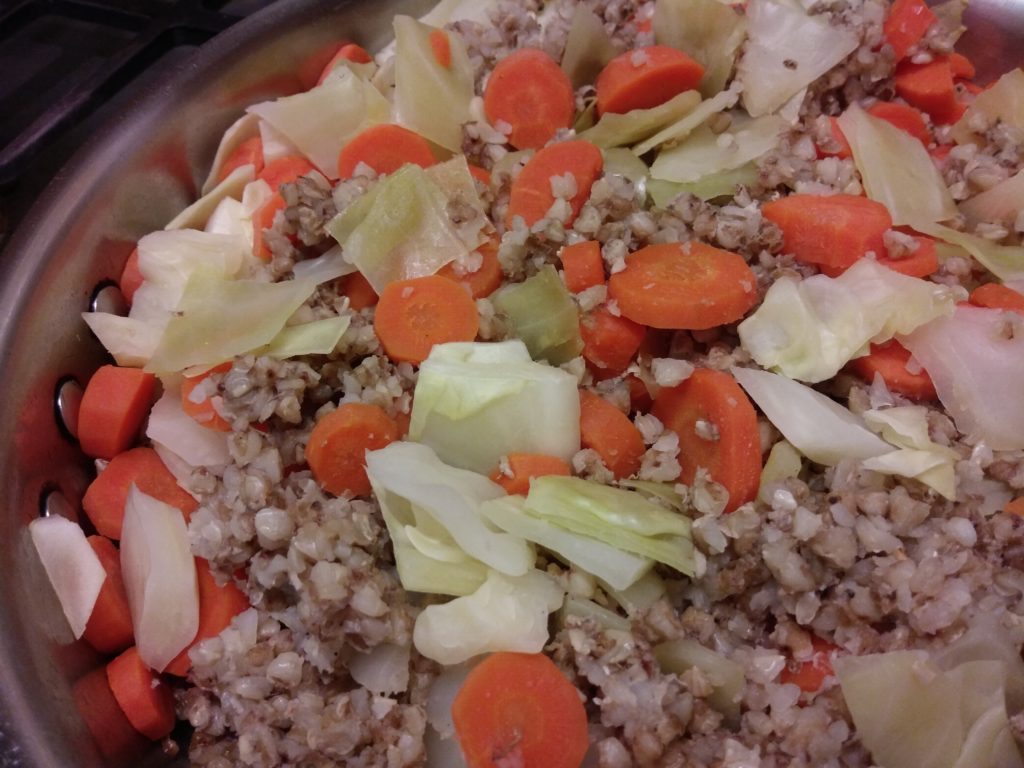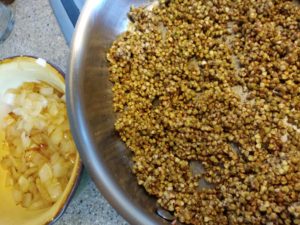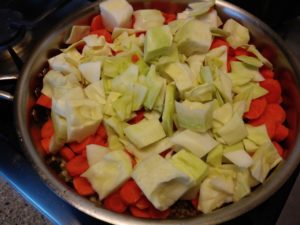
The instructions make this dish look more complicated than it is. Simply put, you just:
- Saute some onions and reserve for adding later.
- In the same pan, toast the buckwheat and spices using the “scrambled egg method.”
- Now simmer the buckwheat with a flavorful broth, gradually adding first carrots and then cabbage to cook with it in a one-pot affair.
- Finally, stir in the onions and serve.
And don’t forget the optional accessories — they are where the real fun comes in. Even take several to the table and let everyone experiment with dressing up this simple dish into something amazingly filling and comforting.
Buckwheat Kasha with Carrots and Cabbage
Step 1: Saute Onion
- 1 Tbsp. olive oil
- 2 cups yellow onion diced to ½” (from about 1 med. onion)
In a medium (10”) skillet with a lid, heat oil over medium heat until hot but not smoking. Add onions and saute, stirring occasionally, until they are lightly browned, about 8-10 minutes. Remove mixture to a bowl and reserve.
Step 2: “Egg Scramble” Buckwheat and Simmer
- 1 egg
- 1 cup white buckwheat**
- 1 Tbsp. olive oil
- 1 tsp. dried rubbed sage
- ¼ tsp. dried leaf thyme
- 2 shakes cayenne pepper
- 2 ¼ cup low-sodium chicken or vegetable broth
- 1/8 to ¼ tsp. sea salt, to taste

In a small mixing bowl, beat egg. Add buckwheat and spices and stir to coat buckwheat thoroughly with egg.
Warm oil over medium low heat in skillet used for onions. Add buckwheat mixture and cook, stirring regularly, until egg is cooked and buckwheat is lightly toasted, being sure to break up any clumps that form. Add broth and salt, cover pan and bring broth to a boil over high heat, then reduce heat to low and simmer, covered, until water is fully absorbed, about 45-50 minutes.
Step 3: Add Vegetables to Simmering Buckwheat
- 2 cups carrots, sliced about 1/8” thick (from about 4 medium-sized carrots so slices are not too large)
- 2 cups green cabbage cut in roughly 1” chunks
After buckwheat has been cooking about 20 minutes, gently spread carrots across top of still-cooking buckwheat, without stirring it. Cover and continue simmering.
After buckwheat and carrots have been cooking another 10 minutes, spread cabbage over carrots, again without stirring. Cover and continue simmering. When liquid appears evaporated, gently separate buckwheat with a fork to see if any liquid is left in bottom of pan.
When liquid is completely absorbed, remove from heat and allow to rest, covered, for 5 to 10 minutes.



Step 4 Add Onions, Fluff and Serve
- Sea salt and fresh ground pepper
Optional Garnishes
- Crumbled goat chevre or whole milk yogurt
- Drizzle of walnut or olive oil
- Chopped fresh flat-leafed parsley
- Chopped and toasted hazelnuts or walnuts
- Squeeze of fresh lemon
- Hot pepper sauce
Add onions to rested buckwheat mixture and use a large fork to gently mix everything together and lightly fluff buckwheat. Season with additional salt and pepper, to taste.
Serve with optional garnishes, as desired.
Seasonal Variations
Once you have the basic recipe down, try it with some different seasonal veggie combos:
- Winter Version: Sauteed mushrooms and onions added at the end along with canned chopped artichoke hearts.
- Summer Version: Green beans steamed with the buckwheat; sauteed onions and red pepper squares added at the end.
** Read more about buckwheat and the difference between milder “white” buckwheat and earthier red buckwheat in this informative article from the Whole Grains Council.